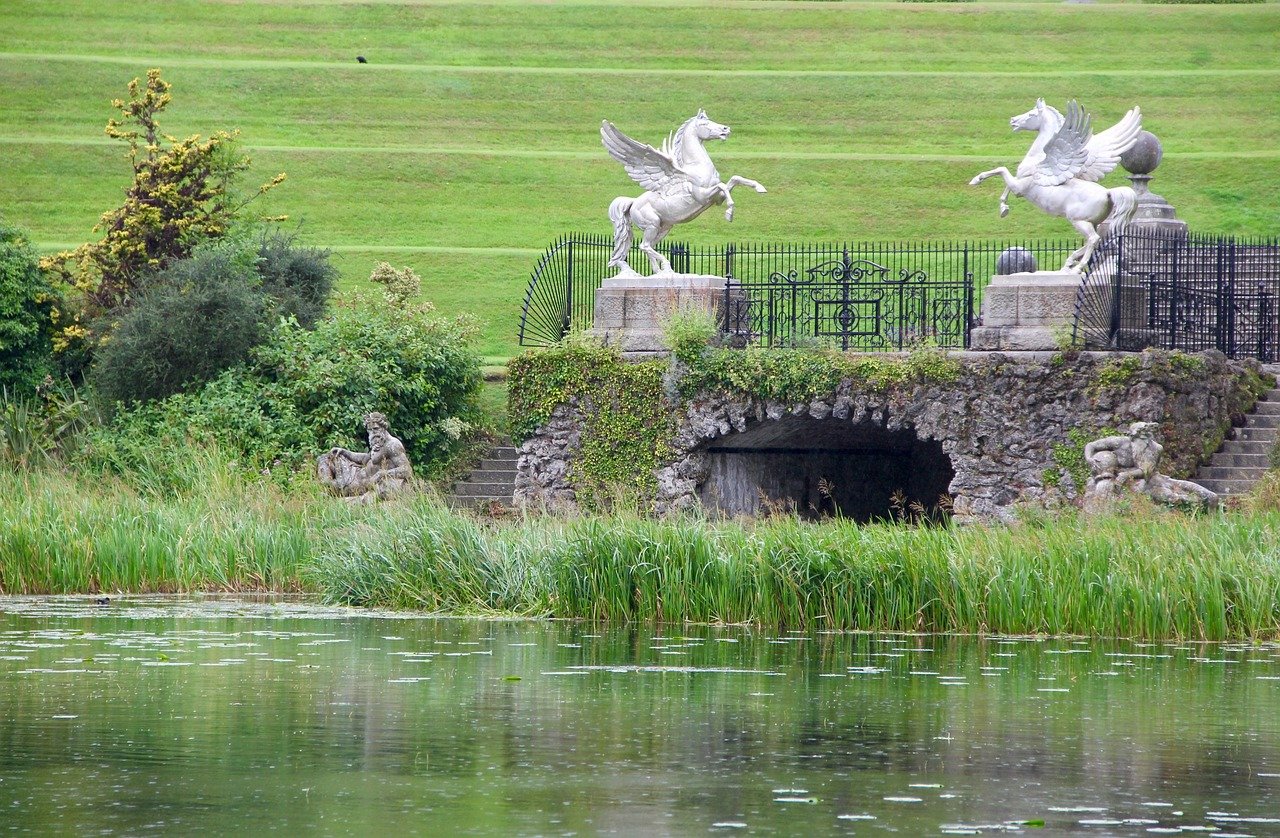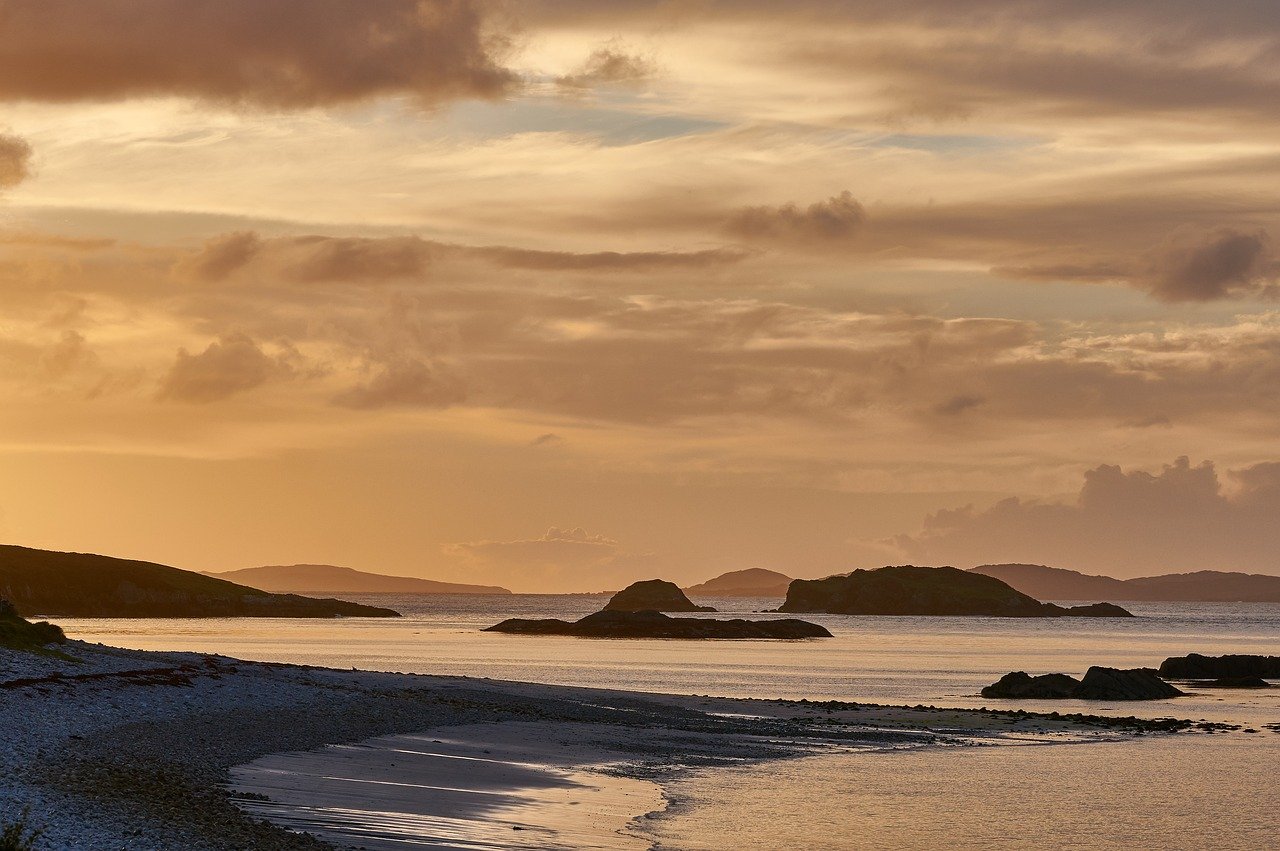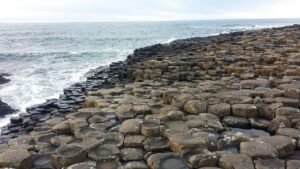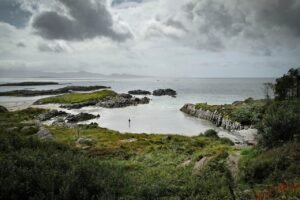
Are you ready to embark on an awe-inspiring journey through the breathtaking landscapes of Ireland? Get ready to uncover the hidden gems and natural wonders that this enchanting country has to offer. From majestic cliffs and rugged coastlines to lush green fields and mystical forests, Ireland’s natural attractions will leave you in awe. Prepare to immerse yourself in the beauty of the Giant’s Causeway, explore the mystical beauty of the Burren, and be captivated by the stunning views from the Cliffs of Moher. Join us as we take you on a captivating adventure through the natural wonders of Ireland.

The Cliffs of Moher
Overview
Welcome to the breathtaking Cliffs of Moher, one of Ireland’s most magnificent natural attractions. Situated along the west coast of County Clare, these cliffs offer mesmerizing panoramic views of the Atlantic Ocean. Towering over 700 feet above the crashing waves, the sheer cliffs create a dramatic and awe-inspiring sight that will leave you spellbound.
Location and Access
Located just a short drive from the town of Liscannor, the Cliffs of Moher are easily accessible from various parts of Ireland. Whether you are exploring the nearby cities of Galway or Limerick, or embarking on a road trip from Dublin, reaching the cliffs is convenient and hassle-free. Visitors can drive to the cliffs and avail of the ample parking facilities available, or alternatively, there are organized tour buses that operate daily.
Geological Formation
The Cliffs of Moher owe their formation to millions of years of erosion by the relentless forces of the Atlantic Ocean. Comprised mainly of layers of shale, siltstone, and sandstone, these towering cliffs have been shaped by the elements into a stunning natural masterpiece. The rugged and jagged cliffs showcase the geological history of Ireland and provide a fascinating insight into the earth’s ancient past.
Wildlife and Bird Watching
The Cliffs of Moher are not only renowned for their majestic beauty but also serve as an important habitat for various species of birds and wildlife. Peregrine falcons, puffins, and rare species of butterflies call these cliffs home, making it a haven for birdwatchers and nature enthusiasts. As you wander along the cliff-edge paths, keep an eye out for the vibrant displays of wildflowers and the occasional glimpse of seals basking on the rocks below.
Activities and Attractions
There are numerous activities and attractions that await you at the Cliffs of Moher. Take a leisurely stroll along the well-maintained cliff-top paths, allowing you to fully immerse yourself in the breathtaking views. For the more adventurous, consider joining a guided cliff-walking tour, providing opportunities to explore hidden caves and secret coves. Additionally, the state-of-the-art visitor center offers informative exhibits, interactive displays, and an audio-visual presentation, providing visitors with a deeper understanding of the cliffs’ natural wonders.
The Giant’s Causeway
Overview
Prepare to be amazed by the wonder that is the Giant’s Causeway. Situated along the rugged coastline of County Antrim in Northern Ireland, this UNESCO World Heritage Site is a geological marvel. It is renowned around the world for its unique and fascinating hexagonal basalt columns, which have captured the imagination of countless visitors.
Location and Access
The Giant’s Causeway is conveniently located off the A2 coastal road, just a short drive from the town of Bushmills. Whether you are exploring Belfast or venturing from other parts of Ireland, reaching the causeway is straightforward. Visitors can park at the nearby visitor center and embark on a scenic walk down to the causeway, or alternatively, there are shuttle bus services available.
Geological Formation
The Giant’s Causeway was formed around 60 million years ago during a volcanic eruption. As molten lava met the cold waters of the Atlantic Ocean, it solidified and contracted, creating the distinctive hexagonal columns that we see today. The interlocking basalt columns, ranging in height from a few inches to towering pillars, form a surreal and other-worldly landscape that has captivated visitors for centuries.
Folklore and Legends
According to local mythology, the Giant’s Causeway is the result of a duel between two giants – the Irish giant Finn MacCool and the Scottish giant Benandonner. Legend has it that Finn MacCool created the causeway to challenge Benandonner to a fight, but upon seeing the Scottish giant’s enormous size, Finn retreated and disguised himself as a baby. When Benandonner saw the size of the “baby”, he assumed that Finn must be even larger and fled back to Scotland, destroying the causeway in his wake.
Visitor Center and Facilities
The Giant’s Causeway Visitor Center provides a wealth of information about the site and the science behind its formation. Interactive exhibits, audio-visual displays, and guided tours are available, ensuring visitors have a comprehensive understanding of the causeway’s geological significance. The center also houses a café and gift shop, perfect for grabbing a bite to eat or picking up a souvenir to commemorate your visit.

The Ring of Kerry
Overview
Embark on a journey of unparalleled beauty along the enchanting Ring of Kerry. This scenic driving route encompasses approximately 179 kilometers and takes you through some of the most breathtaking landscapes in Ireland. As you navigate the winding roads, you will be treated to stunning coastal views, charming villages, and a myriad of natural and cultural wonders.
Scenic Driving Route
The Ring of Kerry takes you on a captivating journey through County Kerry’s diverse landscapes. From the stunning coastline of the Iveragh Peninsula to the majestic mountains and reflective lakes, each turn of the road offers a new and awe-inspiring vista. The route is well-signposted, making it easy to navigate, and there are plenty of opportunities to stop and take in the breathtaking scenery along the way.
Natural Landscapes and Views
One of the highlights of the Ring of Kerry is the exceptional natural beauty that surrounds you at every turn. As you drive through the Killarney National Park, you will be greeted by the grandeur of the McGillycuddy’s Reeks mountain range and the serene lakes of Killarney. Further along the route, the rugged coastal cliffs, pristine sandy beaches, and picturesque countryside will leave you in awe of Ireland’s natural splendor.
Historic and Cultural Sites
The Ring of Kerry is not only a journey through stunning landscapes but also a glimpse into Ireland’s rich history and vibrant culture. Along the route, you will encounter numerous historical and cultural sites, such as ancient stone circles, medieval castles, and charming villages. Be sure to explore the vibrant town of Killarney, with its lively atmosphere, traditional music sessions, and a wealth of dining options.
Outdoor Activities and Hiking
For the adventurous souls, the Ring of Kerry offers plenty of opportunities to immerse yourself in Ireland’s great outdoors. With its abundance of mountains, lakes, and rivers, hiking and hillwalking enthusiasts will find countless trails and paths to conquer. From the iconic Gap of Dunloe to the challenging climb up Carrauntoohil, Ireland’s highest peak, there is something for every level of outdoor enthusiast.
The Burren
Overview
Prepare to be captivated by the unique and mesmerizing landscape of the Burren. Located in County Clare, this karst limestone plateau stands as a testament to the wonders of nature and has become a beloved destination for nature lovers and outdoor enthusiasts.
Geology and Unique Flora
The Burren is renowned for its unique geology and flora. The limestone landscape is characterized by its vast expanses of exposed limestone pavements, allowing rare wildflowers and plants to thrive in this seemingly inhospitable environment. During the spring and summer months, the Burren transforms into a carpet of vibrant hues with the blooms of rare orchids, gentians, and other wildflowers.
Archaeological Sites
Aside from its geological wonders, the Burren is also home to an impressive array of archaeological sites that offer a glimpse into Ireland’s ancient past. Explore the ancient megalithic tombs, such as Poulnabrone Dolmen, or visit the well-preserved Iron Age fort of Caherconnell. These ancient sites provide a fascinating insight into the lives of Ireland’s early inhabitants and are must-see attractions for history enthusiasts.
Guided Tours and Walks
To truly appreciate the beauty and significance of the Burren, consider joining a guided tour or walk led by knowledgeable local experts. These tours offer invaluable insights into the natural and cultural heritage of the area, ensuring you make the most of your visit. Whether you choose to explore on foot or opt for a guided bus tour, you will be rewarded with a deeper understanding and appreciation of the Burren’s wonders.
Conservation Efforts
Due to its unique ecological importance, the Burren is protected as a Special Area of Conservation and a UNESCO Global Geopark. Conservation efforts are ongoing to preserve the fragile ecosystem and ensure that future generations can continue to marvel at its beauty. By visiting the Burren, you are supporting these conservation efforts and contributing to the preservation of this remarkable landscape for years to come.

Killarney National Park
Overview
Immerse yourself in the natural splendor of Killarney National Park, one of Ireland’s most beloved natural treasures. Nestled in County Kerry, this expansive parkland is a haven for flora and fauna, offering visitors a slice of paradise amidst the stunning landscapes of Ireland.
Flora and Fauna
Killarney National Park is a haven for biodiversity, boasting a rich tapestry of plant and animal life. The park is home to ancient oak and yew forests, carpeted with vibrant wildflowers during the warmer months. Rare and protected species, such as the red deer and the Kerry slug, can be spotted within the park’s boundaries, making it a paradise for nature enthusiasts and wildlife lovers alike.
Lakes and Mountains
Killarney National Park is famed for its picturesque lakes, which provide a serene and reflective backdrop to the surrounding mountains. The three main lakes, Lough Leane, Muckross Lake, and Upper Lake, offer stunning vistas and peaceful boat trips. The mountains that frame the park, including the majestic MacGillycuddy’s Reeks and the iconic Torc Mountain, offer unrivaled opportunities for hiking and mountaineering.
Muckross House and Gardens
No visit to Killarney National Park is complete without a visit to the enchanting Muckross House and Gardens. This elegant 19th-century mansion is nestled within the park and provides a glimpse into Ireland’s past. Explore the beautifully preserved rooms of the house, which offer a fascinating insight into the lives of the former occupants. The meticulously manicured gardens, with their vibrant flower displays and serene water features, offer a tranquil oasis within the park.
Outdoor Activities and Boat Tours
Killarney National Park offers a wealth of outdoor activities to suit all interests and skill levels. From leisurely walks along picturesque trails to adrenaline-pumping mountain biking, there is something for everyone. For a truly unique experience, consider taking a boat tour on one of the park’s enchanting lakes. These tours provide a different perspective and allow you to fully appreciate the beauty of the park from the water.
Connemara National Park
Overview
Escape to the wild and rugged beauty of Connemara National Park, located in County Galway. With its stunning mountains, picturesque peatlands, and diverse wildlife, this national park offers a captivating glimpse into the untamed wilderness of western Ireland.
Peatlands and Mountains
Connemara National Park is characterized by its expansive peatlands, which have been shaped by thousands of years of natural processes. Set against a backdrop of towering mountains, the blanket bogs and marshlands create a unique and dramatic landscape. These peatlands, with their vibrant colors and unique vegetation, contribute to the park’s incredible biodiversity and are a joy for nature enthusiasts to explore.
Wildlife and Bird Watching
Connemara National Park is teeming with a variety of wildlife, making it a paradise for birdwatching and wildlife enthusiasts. Keep an eye out for elusive species such as the red deer, the native Connemara pony, and the elusive pine marten. Birdwatchers will be delighted by the numerous species that call the park home, including the iconic red grouse, the majestic white-tailed eagle, and the rare corncrake.
Nature Trails and Hiking
Dotted with a network of well-marked trails, Connemara National Park offers ample opportunities for hiking and nature walks. Whether you are seeking a challenging mountain hike or a leisurely stroll through the park’s enchanting woodlands, there is a trail to suit every level of fitness and interest. Each step offers a new perspective of the park’s natural wonders, ensuring a memorable and immersive experience.
Visitor Center and Facilities
The Connemara National Park Visitor Center serves as a gateway to the park and provides a wealth of information for visitors. The center offers interactive exhibits, educational displays, and audio-visual presentations, allowing visitors to learn about the park’s history, flora, and fauna. Additionally, there is a well-stocked gift shop and a café, where you can relax and refuel after your explorations.
The Skellig Islands
Overview
Step into a realm of natural beauty and ancient history on the Skellig Islands, a UNESCO World Heritage Site off the coast of County Kerry. These remote and awe-inspiring islands offer a glimpse into Ireland’s rich monastic heritage and are an important sanctuary for a variety of seabirds.
Location and Access
Located approximately 12 kilometers off the coast of Portmagee, the Skellig Islands are accessible by boat from the mainland. Access to the islands is weather-dependent, and visits are strictly regulated to ensure the protection of the fragile environment. Visitors must book their boat trips in advance, as the demand for this unique experience is high.
Monastic Settlement
The highlight of a visit to the Skellig Islands is the awe-inspiring monastic settlement on Skellig Michael. Built by early Christian monks between the 6th and 8th centuries, the stone beehive huts and oratories perched on the island’s steep cliffs are a testament to the dedication and skill of these early settlers. The monastic site is incredibly well-preserved and offers a glimpse into the lives of the monks who sought solitude and spiritual reflection on the islands.
Puffins and Seabirds
The Skellig Islands are not only steeped in history but also serve as an important nesting site for a variety of seabirds. Thousands of puffins, guillemots, and razorbills call the rocky cliffs of the islands home during the breeding season, creating a cacophony of sounds and a mesmerizing spectacle. Birdwatchers and nature enthusiasts will be enthralled by the opportunity to observe these incredible creatures up close in their natural habitat.
Star Wars Connection
In recent years, the Skellig Islands have gained international fame as a filming location for the Star Wars movie franchise. The dramatic landscapes and ancient monastic site provided the perfect backdrop for iconic scenes in “Star Wars: The Force Awakens” and “Star Wars: The Last Jedi.” Fans of the movies can now follow in the footsteps of their favorite characters and relive the magic of these films in a truly unique setting.
The Aran Islands
Overview
Escape the hustle and bustle of the mainland and discover the tranquility and charm of the Aran Islands. Located off the coast of County Galway, these rugged and captivating islands offer a glimpse into traditional Irish culture, stunning coastal landscapes, and ancient archaeological sites.
Location and Access
The Aran Islands consist of three main islands – Inis Mór, Inis Meáin, and Inis Oírr – and are accessible by boat from various ports along the Galway and Clare coasts. Regular ferry services operate, and the journey to the islands allows visitors to soak in the scenic beauty of Galway Bay. Once on the islands, visitors can explore by foot, bicycle, or horse-drawn cart, immersing themselves in the relaxed and unhurried pace of island life.
Traditional Irish Culture
The Aran Islands have long been a stronghold of traditional Irish culture and offer a unique insight into island life. Experience the warmth and hospitality of the islanders as you wander through the charming villages, where traditional Irish music can often be heard emanating from cozy pubs. Engage with the locals and learn about their ancient customs, language, and crafts, ensuring a truly enriching cultural experience.
Cycling and Walking Tours
Exploring the Aran Islands by foot or bicycle is a must for those seeking to truly immerse themselves in the island’s scenic beauty. Each island offers a network of well-marked trails that wind through stunning coastal landscapes, pristine sandy beaches, and lush green fields. As you cycle or walk along the paths, you will be rewarded with breathtaking views and a sense of tranquility that can only be found on these remote and unspoiled islands.
Ancient Forts and Stone Walls
The Aran Islands are dotted with ancient forts and imposing stone walls, a testament to the island’s rich archaeological heritage. Dun Aonghasa on Inis Mór, a prehistoric stone fort perched on the edge of a sheer cliff, is one of the most impressive examples of ancient fortifications in Ireland. Inis Meáin and Inis Oírr also boast their own unique archaeological sites, offering visitors a glimpse into the lives of the island’s early inhabitants.
The Wicklow Mountains
Overview
Escape from the hustle and bustle of city life and venture into the enchanting landscape of the Wicklow Mountains. Located just a short drive from Dublin, this mountain range offers a tranquil sanctuary of rolling hills, pristine lakes, and meandering rivers.
Scenic Driving Routes
Exploring the Wicklow Mountains by car is a popular option, offering visitors the opportunity to experience the diverse beauty of the region at their own pace. The Sally Gap, a winding mountain road, offers sweeping views of the surrounding countryside and is a popular route for scenic drives. Alternatively, the Wicklow Mountains can be traversed via the Military Road, which passes through picturesque valleys and offers stunning vistas of the surrounding peaks.
Glendalough Monastic Site
No visit to the Wicklow Mountains is complete without a stop at the ancient monastic site of Glendalough. Nestled in a picturesque valley, this well-preserved monastic settlement dates back to the 6th century and is a testament to Ireland’s rich spiritual heritage. Explore the ruins of the monastic buildings, including the iconic Round Tower, and take a leisurely stroll around the tranquil lakes that give Glendalough its name.
Hiking Trails
For outdoor enthusiasts, the Wicklow Mountains offer a plethora of hiking trails that cater to all levels of fitness and experience. From leisurely walks through picturesque valleys to challenging mountain ascents, there is a trail to suit every interest. One of the most popular hikes is the Wicklow Way, a long-distance trail that winds through the heart of the mountain range, offering panoramic views and a deep connection with nature.
Powerscourt Estate
Nestled at the foot of the Wicklow Mountains, Powerscourt Estate is a magnificent stately home and gardens that exudes grandeur and charm. Explore the meticulously manicured gardens, boasting dazzling displays of vibrant flowers and cascading water features. Take a stroll through the exquisite Japanese Gardens or be captivated by the tranquility of the nearby Powerscourt Waterfall, one of the highest waterfalls in Ireland. The estate’s house, with its stunning architecture and intriguing history, is also worth a visit.
The Dingle Peninsula
Overview
Prepare to be spellbound by the rugged beauty and mystical allure of the Dingle Peninsula. Located in County Kerry, this captivating peninsula offers stunning coastal landscapes, ancient archaeological sites, and a unique connection to Ireland’s Gaelic heritage.
Scenic Driving Route
The Dingle Peninsula is best explored by following the Slea Head Drive, a scenic route that encompasses approximately 47 kilometers of breathtaking coastal views. As you wind your way along the rugged coastline, you will be treated to panoramic vistas of the Atlantic Ocean, soaring sea cliffs, and pristine sandy beaches. The route is well signposted, allowing you to leisurely explore the area at your own pace.
Beaches and Coastal Landscapes
The Dingle Peninsula is home to some of Ireland’s most beautiful and unspoiled beaches. From the golden sands of Inch Beach to the secluded coves of Coumeenoole and Ventry, there is a beach to suit every taste. Immerse yourself in the natural beauty of the peninsula as you stroll along these idyllic stretches of coastline, feeling the sand between your toes and the refreshing sea breeze on your face.
Ancient Sites
For history enthusiasts, the Dingle Peninsula offers a wealth of ancient sites that provide a glimpse into Ireland’s rich past. Visit the impressive ring forts of Dun Beag and Dun Conor, which offer breathtaking views and a fascinating insight into early Irish society. The Gallarus Oratory, a perfectly preserved stone structure dating back over a thousand years, is another must-visit site that showcases the remarkable craftsmanship of Ireland’s early inhabitants.
Gaeltacht and Irish Language
The Dingle Peninsula is part of the Gaeltacht, an area of Ireland where the Irish language (Gaeilge) is spoken on a daily basis. Immerse yourself in the rich Gaelic heritage of the area by visiting the vibrant town of Dingle, where traditional music sessions, storytelling, and the Irish language are celebrated. Engage with locals, learn a few words of Irish, and experience the unique charm of this region, where the Gaelic language and culture are proudly preserved.
In conclusion, Ireland is a treasure trove of natural wonders, each offering a unique experience and enchanting beauty. Whether you find yourself standing in awe at the towering Cliffs of Moher, exploring the hexagonal marvels of the Giant’s Causeway, or immersing yourself in the cultural heritage of the Aran Islands, Ireland’s natural attractions promise to leave an indelible mark on your soul. So pack your bags, embrace the friendly local culture, and embark on a journey of discovery through the stunning landscapes of the Emerald Isle. Ireland’s natural wonders await your eager exploration.







